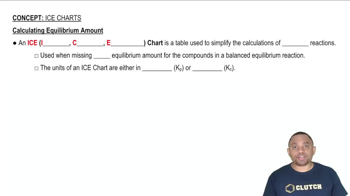For the reaction shown here, Kc = 0.513 at 500 K. N2O4(g) ⇌ 2 NO2(g) If a reaction vessel initially contains an N2O4 concentration of 0.0500 M at 500 K, what are the equilibrium concentrations of N2O4 and NO2 at 500 K?
Ch.15 - Chemical Equilibrium

Chapter 15, Problem 56
Consider the reaction: CO(g) + H2O(g) ⇌ CO2(g) + H2(g) Kc = 102 at 500 K. If a reaction mixture initially contains 0.110 M CO and 0.110 M H2O, what will the equilibrium concentration of each of the reactants and products be?
 Verified step by step guidance
Verified step by step guidance1
Identify the initial concentrations of the reactants: [CO] = 0.110 M and [H2O] = 0.110 M. The initial concentrations of the products [CO2] and [H2] are 0 M.
Set up an ICE (Initial, Change, Equilibrium) table to track the changes in concentrations as the system reaches equilibrium. Let x be the change in concentration for CO and H2O as they react.
Write the expression for the equilibrium constant Kc: Kc = ([CO2][H2])/([CO][H2O]).
Substitute the equilibrium concentrations from the ICE table into the Kc expression: Kc = ((x)(x))/((0.110-x)(0.110-x)).
Solve the equation for x using the given Kc value (102) to find the equilibrium concentrations of all species.
Key Concepts
Here are the essential concepts you must grasp in order to answer the question correctly.
Chemical Equilibrium
Chemical equilibrium occurs when the rates of the forward and reverse reactions are equal, resulting in constant concentrations of reactants and products. In this state, the system is dynamic, meaning that reactions continue to occur, but there is no net change in concentration. Understanding this concept is crucial for analyzing how concentrations shift in response to changes in conditions.
Recommended video:
Guided course

Chemical Equilibrium Concepts
Equilibrium Constant (Kc)
The equilibrium constant (Kc) is a numerical value that expresses the ratio of the concentrations of products to reactants at equilibrium, each raised to the power of their coefficients in the balanced equation. For the given reaction, Kc = [CO2][H2]/[CO][H2O]. This constant provides insight into the position of equilibrium and helps predict the concentrations of species at equilibrium based on initial concentrations.
Recommended video:
Guided course

Equilibrium Constant Expressions
ICE Table (Initial, Change, Equilibrium)
An ICE table is a tool used to organize the initial concentrations, the changes in concentrations as the reaction proceeds, and the equilibrium concentrations of reactants and products. By setting up an ICE table, one can systematically determine how the initial concentrations of CO and H2O will change to reach equilibrium, allowing for the calculation of equilibrium concentrations using the Kc value.
Recommended video:
Guided course

ICE Charts and Equilibrium Amount
Related Practice
Textbook Question
1
views
Textbook Question
For the reaction shown here, Kc = 255 at 1000 K. CO(g) + Cl2(g) ⇌ COCl2(g) If a reaction mixture initially contains a CO concentration of 0.1500 M and a Cl2 concentration of 0.175 M at 1000 K, what are the equilibrium concentrations of CO, Cl2, and COCl2 at 1000 K?
2
views
Textbook Question
Consider the reaction: HC2H3O2(aq) + H2O(l) ⇌ H3O+(aq) + C2H3O2-(aq) Kc = 1.8⨉10-5 at 25°C If a solution initially contains 0.210 M HC2H3O2, what is the equilibrium concentration of H3O+ at 25 °C?
2
views
Textbook Question
Consider the reaction: SO2Cl2(g) ⇌ SO2(g) + Cl2(g) Kc = 2.99⨉10-7 at 227 °C If a reaction mixture initially contains 0.175 M SO2Cl2, what is the equilibrium concentration of Cl2 at 227 °C?
1
views
